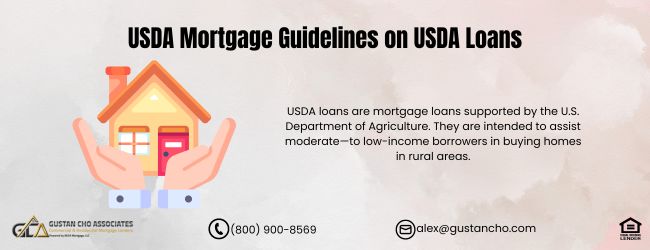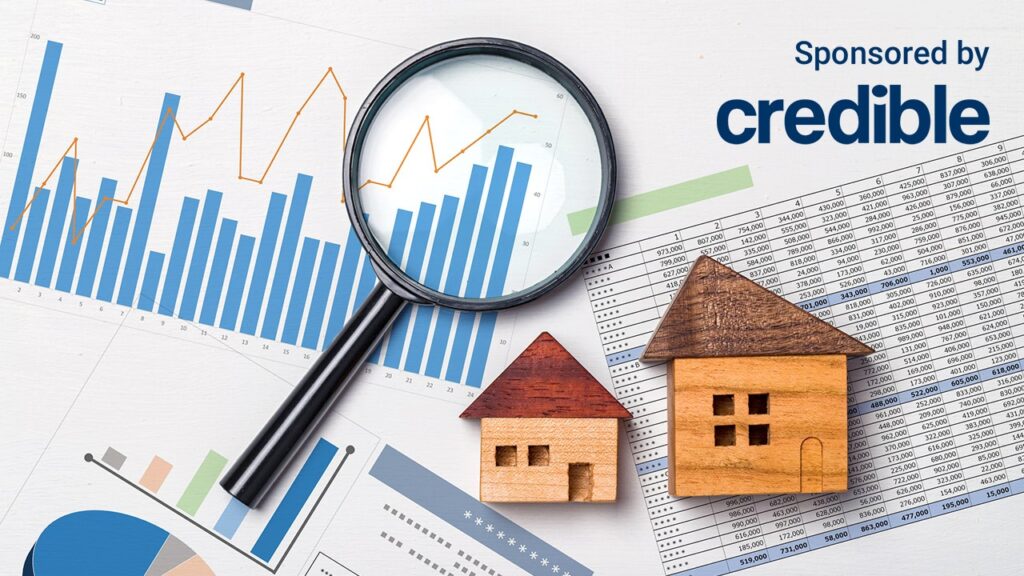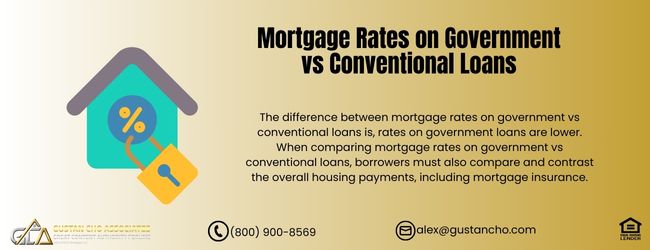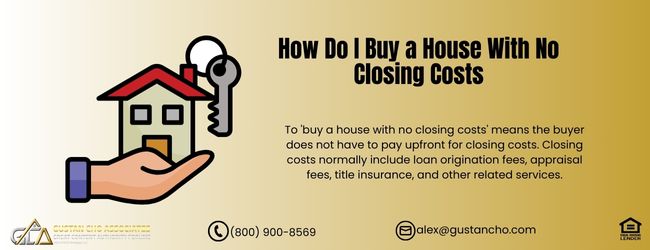USDA Mortgage Guidelines on USDA Loans

This guide covers USDA mortgage guidelines on USDA loans. USDA allows home buyers to purchase a home with no money down. Per USDA mortgage guidelines 100% financing is allowed on USDA home loans. Closing costs can be covered with seller concessions or lender credit. USDA mortgage guidelines allows up to 6% seller concession by home sellers. Homebuyers can use sellers concessions for closing costs. If the home buyer is short in covering closing costs with seller concessions, the lender can offer lender credit in lieu of a higher mortgage interest rate. USDA has property eligibility requirements and maximum household income guidelines unlike other loan programs. In this blog, we will cover USDA mortgage guidelines versus lender overlays.
What Are USDA Loans
USDA loans, backed by the U.S. Department of Agriculture, are designed to help moderate- to low-income borrowers purchase homes in rural areas. Here are the key guidelines for USDA loans. The property must be located in an eligible rural area as defined by USDA. You can check property eligibility on the USDA’s website.
Credit Score: While USDA does not set a minimum credit score, lenders typically require a score of 640 or higher for automatic underwriting approval. Lower scores may still be approved through manual underwriting but require additional documentation.
USDA Loan Features
USDA loans require no down payment, allowing borrowers to finance up to 100% of the home’s purchase price. USDA loans typically offer 30-year fixed-rate terms. Interest rates for USDA loans are often lower than those of conventional and FHA loans. Click here to apply for USDA loan
Mortgage Insurance on USDA Loans
Instead of mortgage insurance, a guarantee fee can be rolled into the loan amount. The upfront guarantee fee is 1% of the loan amount, and the annual fee is 0.35% of the loan balance. The home must be in good repair and meet the USDA’s standards regarding structural quality, roofing, plumbing, etc. The property must be the borrower’s primary residence.
USDA Mortgage Loan Process
Applicants must fill out a loan application through a USDA-approved lender. The lender will evaluate creditworthiness, debt-to-income ratio, and other financial indicators. The loan application is sent to the local USDA office for final approval after the lender’s approval. The program is designed to make homeownership more accessible to those in rural areas and to stimulate economic growth in less densely populated communities. For more detailed information or to apply for a USDA loan, it is recommended that you visit a USDA-approved lender. This resource will provide up-to-date details on eligibility, application processes, and more.
USDA Mortgage Guidelines on Property and Income
Not all areas qualify for USDA loans. Per USDA mortgage guidelines, the subject property needs to be located in a USDA designated area. It does not necessarily be in an agricultural area. Many suburbs of major cities are designated as USDA designated eligible rural areas. USDA Agency Mortgage Guidelines also has a maximum household income limit. Income Limits:
Applicants must meet income eligibility requirements, which vary by region and family size. The income used to qualify must be stable and dependable. USDA uses an adjusted income considering various deductions such as child care expenses.
Borrowers cannot exceed the maximum income limit required by the USDA. The maximum household income limit depends on the number of people in a household versus household income. This loan program was created and launched to help low-income to moderate-income families become homeowners in rural areas. Speak With Our Expert for qualify for USDA mortgage process
USDA Agency Mortgage Guidelines on Borrower and Property Eligibility
The best part of USDA loans is it allows no down payment by homebuyers with 100% financing. The program allows for up to 6% sellers concessions so most home buyers do not have to worry about closing costs. Not all areas qualify for USDA Financing. The property needs to be in a rural area that has been approved by the USDA. The area does not need to be in a farm area.
Many suburbs of major cities are qualified as eligible areas. Many areas in the United States are classified as eligible areas. The USDA eligibility tool is a system where home buyers can enter the zip code of the area they are interested in buying.
The tool will tell viewers whether or not the area is an approved USDA rural approved area. USDA is the only loan program that has a maximum household income limit. Borrowers making a lot of household income would not be eligible for financing. Here is the link to determine whether or not you meet the maximum income eligibility requirements to qualify for USDA loan.
Data Borrowers Required To Determine USDA Mortgage Guidelines
The following information will be needed to see if the subject property is located in a USDA eligible rural area:
- State the property is in
- City and county of the subject property and the nearest metropolitan city
- Amount of people in the household
- Children or dependent under 18 years of age
- Disabled and full-time student in the household
- Are borrowers (including co-borrowers) seniors and 62 years of age or older?
- Monthly debts which include child care, elderly care, ongoing medical and disability expenses
- Household income
- Non-borrower spouse’s income is part of household income
USDA loans cap the front-end debt-to-income ratio to 29% and back-end debt-to-income ratio to 41%. USDA loans is one of two loan programs that allow 100% financing. VA Loans is the other loan program that allows no down payment and 100% financing. However, you need to be an active and/or retired member of the U.S. Armed Services with a valid Certificate of Eligibility to qualify for VA loans.
USDA Mortgage Guidelines on Credit and DTI
The minimum credit score of 580 FICO is required. Maximum debt to income ratio is 29% front end and 43% back end. Need automated approval per the Guaranteed Underwriting System also referred to as GUS. GUS is an Automated Underwriting System (AUS) that is used to receive findings to determine a borrower’s eligibility. GUS renders the following:
- Approve/Eligible
- Refer/Eligible
- Refer with Caution
GUS determines the borrower’s eligibility by analyzing the borrowers’ credit, capacity, and collateral in a matter of seconds.
USDA Mortgage Guidelines After Bankruptcy and Housing Event
Borrowers can qualify for USDA loans after bankruptcy, foreclosure, deed-in-lieu of foreclosure, short sale. However, there are mandatory waiting period requirements. There is a three-year waiting period to qualify for USDA Loans after a Chapter 7 or Chapter 13 Bankruptcy discharged date.
There is a three-year waiting period to qualify for USDA loans after foreclosure, deed in lieu of foreclosure, short sale. Unlike VA and FHA loans, borrowers cannot qualify for USDA loans during a Chapter 13 Bankruptcy repayment plan.
There is manual underwriting on USDA loans. Therefore, there is a two-year waiting period after Chapter 13 Bankruptcy discharged date to qualify for USDA loans. If you have any questions on this blog or other mortgage topics, please contact us at Gustan Cho Associates at 800-900-8569 or text us for faster response. Or email us at gcho@gustancho.com.
Click here to apply for USDA mortgage after bankruptcy and house event
FAQs: USDA Mortgage Guidelines on USDA Loans
- What are USDA loans? USDA loans are mortgage loans supported by the U.S. Department of Agriculture. They are intended to assist moderate—to low-income borrowers in buying homes in rural areas.
- What are the benefits of USDA loans? USDA loans offer 100% financing with no down payment, lower interest rates, and the option to cover closing costs with seller concessions or lender credit.
- Who is eligible for a USDA loan? Eligibility depends on income limits, which vary by region and family size. The property must be located in a USDA-eligible rural area.
- How do I check if a property is eligible? Using their eligibility tool, you can check property eligibility on the USDA’s website.
- What are the credit score requirements? Lenders usually require a credit score of 640 or higher for automatic underwriting approval, while the USDA does not set a specific minimum credit score. If the score is lower, manual underwriting may be an option with additional documentation.
- What are the main features of a USDA loan? USDA loans offer 30-year fixed-rate terms, require no down payment, and typically feature lower interest rates than conventional and FHA loans.
- What is the USDA guarantee fee? Instead of mortgage insurance, USDA loans require a 1% initial guarantee fee and an annual fee of 0.35% of the loan balance.
- How do I apply for a USDA loan? Applicants must complete a loan application through a USDA-approved lender. The lender evaluates creditworthiness and other financial indicators before sending the application to the local USDA office for final approval.
- What are the income eligibility requirements? The income limits differ depending on the region and the size of the family. Applicants must adhere to these limits and demonstrate consistent and reliable earnings. The USDA takes into account different deductions, including expenses for child care.
- What are the property eligibility requirements? The property must be located in a USDA-designated rural area, meet the USDA’s standards for structural quality, roofing, and plumbing, and be the borrower’s primary residence.
- How can closing costs be covered? Up to 6% seller concessions or lender credit can cover closing costs in exchange for a higher mortgage interest rate.
- What are the debt-to-income ratio requirements? USDA loans cap the front-end debt-to-income ratio at 29% and the back-end ratio at 41%.
- What is the minimum credit score required? The minimum credit score required is 580 FICO.
- Can I qualify for a USDA loan after bankruptcy or foreclosure? Yes, but there are mandatory waiting periods. According to company policies, there is a three-year waiting period after a Chapter 7 or Chapter 13 bankruptcy discharge, foreclosure, deed in lieu of foreclosure, or short sale. This waiting period applies to certain financial situations.
- Can I qualify for a USDA loan during a Chapter 13 bankruptcy repayment plan? No, borrowers cannot qualify for USDA loans during a Chapter 13 bankruptcy repayment plan. However, there is a two-year waiting period after the Chapter 13 discharge date.
- How can I get more information or apply for a USDA loan? For additional details or to submit an application for a USDA loan, reach out to Gustan Cho Associates at 800-900-8569, text for a quicker reply, or use gcho@gustancho.com to send an email.
For more details, watch a video on USDA mortgage guidelines and visit the USDA-approved lender for up-to-date information on eligibility and application processes.







Responses